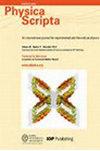氢气中空心阴极放电模拟
IF 2.6
3区 物理与天体物理
Q2 PHYSICS, MULTIDISCIPLINARY
引用次数: 0
摘要
利用二维流体模型模拟了氢气中压力为 2 托的矩形空心阴极放电(HCD)。计算了电势、电场、粒子密度和平均电子温度。放电空间由阴极电极附近的阴极鞘区域和放电池中心区域的负辉光(NG)区域组成。阴极鞘区和负辉区分别存在数千伏/厘米的高电场和数十伏/厘米的低电场。阴极鞘区的电子平均温度为数十 eV,明显高于 NG 区。电子和 H3+ 是主要的负粒子和正离子,它们的峰值出现在 NG 区域,峰值大小约为 1010 cm-3。H 原子是除 H2 以外密度最高的中性粒子,峰值密度为 1013 cm-3。研究探讨了不同粒子生成和消耗的反应动力学。结果表明,每个反应都会产生某些粒子,同时消耗其他粒子,最终实现各种粒子密度的动态平衡。电子主要来源于电子和 H2 之间的基态电离(e+H2 → e+H2++e),并被离解附着(e+H2 → H-+H)消耗掉。电荷转移碰撞反应(H2++H2 → H3++H)是唯一产生 H3+ 离子的反应。消耗 H3+ 离子的不同反应差别不大。H 的生成和消耗主要源于电子碰撞解离反应(e+H2 → e+H+H)和电离反应(e+H→H++2e)。本文章由计算机程序翻译,如有差异,请以英文原文为准。
Simulation on the hollow cathode discharge in hydrogen
A rectangular hollow cathode discharge (HCD) in hydrogen with a pressure of 2 Torr is simulated using a 2-D fluid model. The potential, electric field, particle density, and average electron temperature are calculated. The discharge space consists of the cathode sheath region near the cathode electrode and the negative glow (NG) region in the central region of the discharge cell. A high electric field of thousands of V/cm and a low electric field of tens of V/cm appear in the cathode sheath region and NG region, respectively. The average electron temperature in the cathode sheath region is tens of eV, which is significantly higher than that in the NG region. Electrons and H3+ are the main negative particles and positive ions, whose peaks appear in the NG region, and the peak magnitude is on the order of 1010 cm−3. H atom is the highest-density neutral particle other than H2 with a peak density of 1013 cm−3. The reaction kinetics of the generation and consumption of different particles are explored. The results show that each reaction generates certain particles while consuming other particles, ultimately achieving a dynamic equilibrium in the density of various particles. The electrons mainly originate from the ground state ionization between electron and H2 (e+H2 → e+H2++e) and are consumed by the dissociative attachment (e+H2 → H−+H). The charge transfer collision reaction (H2++H2 → H3++H) is the only reaction that produces H3+ ions. Different reactions to the consumption of H3+ ions do not differ significantly. The generation and consumption of H mainly originate from the electron collision dissociation reaction (e+H2 → e+H+H) and the ionization reaction (e+H→H++2e).
求助全文
通过发布文献求助,成功后即可免费获取论文全文。
去求助
来源期刊

Physica Scripta
物理-物理:综合
CiteScore
3.70
自引率
3.40%
发文量
782
审稿时长
4.5 months
期刊介绍:
Physica Scripta is an international journal for original research in any branch of experimental and theoretical physics. Articles will be considered in any of the following topics, and interdisciplinary topics involving physics are also welcomed:
-Atomic, molecular and optical physics-
Plasma physics-
Condensed matter physics-
Mathematical physics-
Astrophysics-
High energy physics-
Nuclear physics-
Nonlinear physics.
The journal aims to increase the visibility and accessibility of research to the wider physical sciences community. Articles on topics of broad interest are encouraged and submissions in more specialist fields should endeavour to include reference to the wider context of their research in the introduction.
 求助内容:
求助内容: 应助结果提醒方式:
应助结果提醒方式:


